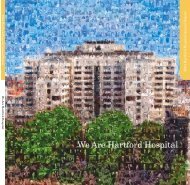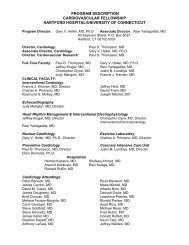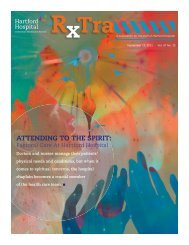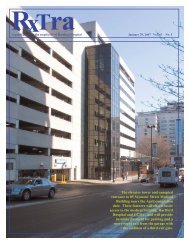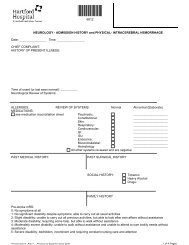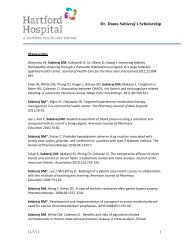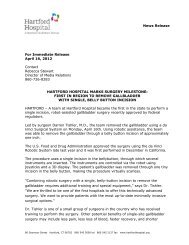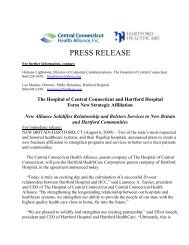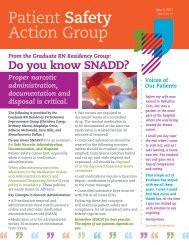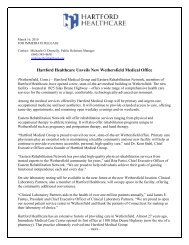The Record: The Institute of Living Annual ... - Hartford Hospital!
The Record: The Institute of Living Annual ... - Hartford Hospital!
The Record: The Institute of Living Annual ... - Hartford Hospital!
Create successful ePaper yourself
Turn your PDF publications into a flip-book with our unique Google optimized e-Paper software.
<strong>The</strong><br />
<strong>Record</strong><br />
inside:<br />
Stimulating<br />
Recovery from<br />
Depression<br />
T H E I N S T I T U T E O F L I V I N G • 2 0 0 9 A N N U A L R E V I E W ( P u b l i s h e d S p r i n g 2 0 1 0 )
contents<br />
1<br />
1<br />
On and Off Campus<br />
Items <strong>of</strong> special interest from the year<br />
2<br />
A Guiding Star<br />
New techniques help children cope<br />
3<br />
Stimulating Recovery<br />
Relieving depression through TMS<br />
10<br />
In Memoriam<br />
Fond farewell to two friends<br />
Depression Initiative Launched<br />
A major campaign to expand research<br />
and clinical services<br />
11<br />
<strong>The</strong> Year in Review<br />
Leadership’s perspective on<br />
the year<br />
12<br />
Awards, Honors and Distinctions<br />
14<br />
Statistics<br />
15<br />
Research Projects<br />
16<br />
Programs and Services<br />
17<br />
<strong>Annual</strong> Gifts<br />
On the Cover:<br />
Drs. Joanna Fogg-Waberski and John<br />
Goethe <strong>of</strong> the <strong>Institute</strong>’s Transcranial<br />
Magnetic Stimulation Service<br />
Children’s Art<br />
Brightens Braceland<br />
Mary Gratton, Program Director <strong>of</strong><br />
Child and Adolescent Services, had<br />
a bright idea last summer: Why not<br />
enliven an unused space in the Braceland<br />
Building lobby with art created by<br />
students at the <strong>Institute</strong>’s Grace Webb<br />
School?<br />
Ann Sheffi eld, the art teacher at<br />
the school, engaged children <strong>of</strong> all ages<br />
from Kindergarten up in creating construction-paper<br />
sunfl owers. Before long,<br />
the cheery blooms were decorating the<br />
walls <strong>of</strong> the fl edgling art gallery.<br />
“It was wonderful to see all these<br />
sunflowers greet you when you walked<br />
into the building,” says Ms. Sheffield.<br />
“<strong>The</strong>y’re bright and cheery, and each<br />
is unique. Each is the child’s own<br />
creation.”<br />
Ms. Sheffi eld says the display will<br />
be changed seasonally “or whenever the<br />
spirit moves us.”<br />
Lobbies Renovated<br />
<strong>The</strong> lobby areas <strong>of</strong> both the Gengras and Donnelly Buildings are more welcoming and more<br />
functional, thanks to recent renovations.<br />
<strong>The</strong> Gengras Building, which was constructed in the 1960s, had had little done to it<br />
since the early 1980s. When the <strong>Institute</strong> decided to consolidate several outpatient services<br />
there, it was clear that the space would need extensive renovation. <strong>The</strong> work was completed<br />
in October 2009.<br />
Today, the handsome new space is home to the Geriatric Psychiatry, Adult Outpatient,<br />
and Memory Disorders programs. <strong>The</strong> lobby complies with all requirements <strong>of</strong> the Americans<br />
with Disabilities Act and with all HIPAA privacy requirements. Most importantly, it is a<br />
place where patients—many <strong>of</strong> whom are elderly—can feel comfortable.<br />
<strong>The</strong> Donnelly Building dates from the early 80s. Over the last four years, the Insti-<br />
tute has systematically refurbished all the<br />
building’s patient units, as well as areas on the<br />
ground fl oor. <strong>The</strong> redesign and rebuilding <strong>of</strong><br />
public spaces, notably the fi rst-fl oor lobby, is<br />
the fi nal phase <strong>of</strong> the project. <strong>The</strong> new lobby<br />
area includes more space and seating, a recep-<br />
tion desk and attractive new terrazzo fl ooring<br />
that could last 100 years.<br />
<strong>The</strong> renovations incorporate the hospi-<br />
tal’s newly adopted, institution-wide interior<br />
design standards, which blend state-<strong>of</strong>-the-art<br />
functionality with classic designs.
Research Grants<br />
Reach All-Time High<br />
Researchers at the <strong>Institute</strong> <strong>of</strong> <strong>Living</strong><br />
were awarded $7.2 million in research<br />
grants in fi scal year 2009. This<br />
is more than awarded in any previous<br />
year and represents a 44 percent increase<br />
over 2007.<br />
“<strong>The</strong> <strong>Institute</strong> <strong>of</strong> <strong>Living</strong> is the<br />
highest grant-receiving department at<br />
<strong>Hartford</strong> <strong>Hospital</strong>,” says Laurine Bow,<br />
PhD, Vice President <strong>of</strong> Research. “It<br />
is a testament to the academic excellence<br />
<strong>of</strong> its leadership and faculty<br />
and to how completely research is integrated<br />
into the IOL’s structure and<br />
clinical services.”<br />
IOL investigators are national<br />
leaders in research aimed at better understanding<br />
and treating a wide range<br />
<strong>of</strong> psychiatric disorders. For example,<br />
David Glahn, PhD, <strong>of</strong> the IOL’s Olin<br />
Neuropsychiatry Research Center is<br />
working on a National <strong>Institute</strong>s <strong>of</strong><br />
Health-funded study designed to advance<br />
efforts to identify the genetic<br />
roots <strong>of</strong> bipolar disorder. David Tolin,<br />
PhD, Director <strong>of</strong> the <strong>Institute</strong>’s Anxiety<br />
Disorders Center is using a grant<br />
from the National <strong>Institute</strong> <strong>of</strong> Mental<br />
Health to investigate whether giving<br />
patients suffering from panic disorders<br />
a cognition-enhancing medication<br />
can help them respond more quickly<br />
to cognitive-behavioral therapy and,<br />
therefore, feel better sooner.<br />
For more on research at the <strong>Institute</strong>,<br />
visit harthosp.org/<strong>Institute</strong>Of<strong>Living</strong>/Research<br />
<strong>Institute</strong> Ranked Best for Psychiatry<br />
on&<strong>of</strong>f campus<br />
In the photo, from left to right are: E. Clayton (Skip) Gengras, Jr., IOL<br />
Board Chairman; Harold I. (Hank) Schwartz, M.D., Psychiatrist-in-Chief<br />
and V.P. Behavioral Health; David J. Kupfer, M.D., Burlingame Award<br />
Recipient; Elliot Joseph, President & CEO, <strong>Hartford</strong> <strong>Hospital</strong> and <strong>Hartford</strong><br />
Healthcare Corporation.<br />
2009 Burlingame Award Presented<br />
<strong>The</strong> <strong>Institute</strong> presented David J. Kupfer, MD, with its prestigious C. Charles Burlingame,<br />
MD, Award for 2009.<br />
Dr. Kupfer is the Thomas Detre Pr<strong>of</strong>essor and Chairman <strong>of</strong> the Department <strong>of</strong> Psychiatry<br />
at the University <strong>of</strong> Pittsburgh School <strong>of</strong> Medicine and Director <strong>of</strong> Research at Western<br />
Psychiatric <strong>Institute</strong> and Clinic, one <strong>of</strong> the nation’s pre-eminent university-based psychiatric<br />
centers. Dr. Kupfer holds the distinction <strong>of</strong> chairing the American Psychiatric Association’s<br />
DSM-V Task Force, which is revising the Diagnostic and Statistical Manual <strong>of</strong> Psychiatry, the<br />
comprehensive reference work used by mental health pr<strong>of</strong>essionals nationwide.<br />
For more than 25 years, Dr. Kupfer’s research has focused primarily on mood disorders. He<br />
has published hundreds <strong>of</strong> articles, books and book chapters that examine treatment <strong>of</strong> recurrent<br />
depression, causes <strong>of</strong> depression and the relationship between biomarkers and depression.<br />
Dr. Kupfer earned both his undergraduate and medical degrees from Yale University and<br />
continued his postgraduate clinical and research training at Yale-New Haven <strong>Hospital</strong> and<br />
the National <strong>Institute</strong> <strong>of</strong> Mental Health.<br />
For the third consecutive year, <strong>Hartford</strong> <strong>Hospital</strong>’s <strong>Institute</strong> <strong>of</strong> <strong>Living</strong> was ranked among the nation’s top psychiatric facilities on U.S.News &<br />
World Report’s list <strong>of</strong> America’s Best <strong>Hospital</strong>s. <strong>The</strong> <strong>Institute</strong> ranked at number 19 in 2009, four spots higher than its 2008 ranking. <strong>The</strong> <strong>Institute</strong><br />
was among only 174 hospitals—and one <strong>of</strong> only two in Connecticut—selected out <strong>of</strong> 4,861 hospitals screened. This distinction places the<br />
<strong>Institute</strong> among the top 4 percent <strong>of</strong> hospitals nationwide.<br />
“We’re thrilled to be recognized in this way,” says IOL Psychiatrist-in-Chief Harold “Hank” Schwartz, MD. “We believe this is a refl ection<br />
<strong>of</strong> the caliber <strong>of</strong> our research programs, the competitiveness <strong>of</strong> our residency training programs and the degree to which research and education<br />
are integrated into our clinical programs.”<br />
142
3<br />
A<br />
Guiding<br />
Star
Innovative sensory modulation<br />
techniques are helping the <strong>Institute</strong>’s<br />
youngest patients calm themselves.<br />
An individualized star is a handy reminder.<br />
For children and adolescents who come to the <strong>Institute</strong> <strong>of</strong> <strong>Living</strong>, life has <strong>of</strong>ten been hard. Some arrive<br />
scarred by trauma—physical, emotional or sexual abuse; violence witnessed at home or on the street;<br />
absent or deceased parents; or years <strong>of</strong> institutional or foster care. Others have psychiatric conditions<br />
such as mood disorders, psychotic symptoms or forms <strong>of</strong> autism. Understandably, many <strong>of</strong> these young<br />
patients struggle with volatile emotions that can sometimes lead to outbursts that could result in harm<br />
to themselves or others. In years past, restraining or secluding highly agitated patients was the only way<br />
to keep patients and staff safe. But today, an innovative approach called sensory modulation is helping<br />
children learn to recognize when they’re becoming upset and calm themselves before their feelings erupt<br />
into destruction or violence.<br />
“Sensory modulation is an approach that uses sensory modalities such as touch, sound, smell, taste and<br />
sight to help children refocus, reintegrate and calm down when agitated,” says Mary Gratton, PhD, Pro-<br />
gram Director <strong>of</strong> Child and Adolescent Services. “It is strength-based and focuses on helping children<br />
identify and use ways <strong>of</strong> coping when they begin to feel distressed.”<br />
Sensory modulation is used in all areas with young patients: the adolescent and child inpatient units,<br />
CARES emergency-stabilization unit, TOPS extended day treatment program, partial hospital programs<br />
and the Webb schools.<br />
<strong>The</strong> approach has proved very successful. Self-injurious behavior on the adolescent inpatient unit has<br />
declined dramatically. Former seclusion rooms have been closed or converted into “comfort rooms” with<br />
features such as thick carpeting and comfy beanbag chairs. In the TOPS program, it’s been at least 18<br />
4
5<br />
months since restraint had to be used. <strong>The</strong> nurse manager <strong>of</strong> the child inpatient unit, who has worked<br />
with children ages 5 to 17 at the <strong>Institute</strong> since 1996, says she “can’t remember the last time we secluded<br />
anyone, and we rarely use restraint.”<br />
Choosing Favorite Sensory Activities<br />
<strong>The</strong> sensory modulation approach is based on respecting the child’s feelings and eliciting the child’s<br />
input on what helps him or her feel calmer. As soon as children are admitted, staff members sit down<br />
with children and go through a document called the “sensory diet,” a list <strong>of</strong> activities children may fi nd<br />
soothing. <strong>The</strong> sensory diet is available in both English and Spanish. Activities are grouped into catego-<br />
ries: movement, touch, listening, seeing and smelling. Activities might include running, lifting weights,<br />
rocking, doing arts or crafts, cuddling a s<strong>of</strong>t toy, listening to music or ocean sounds, watching fi sh in a<br />
tank, or smelling various fragrances or aromas.<br />
“We go through the list and talk with them about what makes them feel better when they’re feeling frus-<br />
trated or upset,” says Sandra Marshall, MSN, Nurse Manager <strong>of</strong> the child inpatient and CARES units.<br />
“Each child is unique. Even little kids are very defi nite about what they like and don’t like. <strong>The</strong>ir eyes<br />
light up when you mention something they like to do.”<br />
<strong>The</strong> children ultimately choose the fi ve sensory activities they believe are the most helpful to them.<br />
<strong>The</strong>se are written on the points <strong>of</strong> a fi ve-pointed star. <strong>The</strong> star is then affi xed to the door <strong>of</strong> the child’s<br />
room, where it serves as a visual cue for both the child and the staff about what works for that particular<br />
child. A copy <strong>of</strong> the star is also placed in the patient’s chart.<br />
When a child begins to get upset, angry or anxious, staff can encourage the child to turn to a favorite<br />
activity. Eventually, the child will get to the point where he/she will do this on his/her own.<br />
Gloricel Rodriguez-Lebron, MSW, Treatment Manager in the TOPS program, uses a modifi ed version <strong>of</strong><br />
the sensory diet for the 11- to 14-year-olds in this extended day treatment program. It includes activities<br />
they can engage in at home or in school.<br />
“<strong>The</strong> sensory diet is a way to explore what coping skills they already use and what skills they would like<br />
to use to calm themselves down,” she says.<br />
Ms. Rodriguez-Lebron adds that it’s not unusual for kids to do things such as draw or play with Silly<br />
Putty® during group therapy sessions. Talking openly about their feelings and experiences make them<br />
feel vulnerable, she says, and the sensory activity “is a way <strong>of</strong> dealing with anxiety.”<br />
Part <strong>of</strong> the approach is having a rich array <strong>of</strong> resources in the environment. Each unit has “sensory carts”<br />
containing items such as CDs and headphones, Silly Putty®, textured stress balls, Lego® blocks and<br />
games. Children can borrow any <strong>of</strong> the items on the cart. Large physiology balls on each unit provide an<br />
active outlet for emotions. Comfort rooms, mentioned earlier, are cozy, quiet places to retreat to when a<br />
child feels the need to be alone.<br />
Sensory Modulation in Action<br />
Before initiating sensory modulation, a team from the <strong>Institute</strong> took part in an educational program at<br />
Vermont’s Brattleboro Retreat. Since then, staff members have had countless opportunities to see the<br />
concept in action.
Chad Blackak, BSN, Nurse Manager <strong>of</strong> the adolescent inpatient unit, recalls a recent patient who had<br />
Asperger’s syndrome, an autism-spectrum disorder. <strong>The</strong> patient had impaired communications skills.<br />
One day, the child began to get upset and frustrated, misinterpreting a situation and thinking that others<br />
were talking about him.<br />
“We redirected him to use the physiology ball, and he bounced on it for more than an hour,” Mr. Blackak<br />
says. “<strong>The</strong>n he was able to come back out on the unit as if nothing had ever happened. He used it many<br />
times after that, because he realized that it worked for him.”<br />
A child new to the TOPS extended day treatment program was having a hard time, Gloricel Rodri-<br />
guez-Lebron recalls. He was anxious about being there and uncomfortable around the other children.<br />
He left the room where group therapy was taking place and began pacing in the hallway, insisting that<br />
he wanted to leave. Acting on his choices on the sensory diet list, Ms. Rodriguez-Lebron helped him<br />
dampen a towel with cold water and put it on his forehead, and she <strong>of</strong>fered him chewing gum.<br />
“Fifteen minutes later, he was back in the group,” she says.<br />
<strong>The</strong> Relational Model<br />
Sensory modulation dovetails well with the relational model <strong>of</strong> care the <strong>Institute</strong> primarily uses today in<br />
dealing with children and adolescents. <strong>The</strong> relational model is based on the clinician’s getting to know<br />
the child, understanding and respecting the child’s feelings and building trust.<br />
“<strong>The</strong> idea is to build a relationship from the second the patient walks in,” says Chad Blackak. “You ask<br />
them about themselves and show that you have a genuine interest in them. Patients know when you<br />
care and when you don’t.”<br />
Mr. Blackak tries to fi nd common interests—music or sports, for example—that he can talk with the<br />
child about.<br />
“Adolescents <strong>of</strong>ten feel we have no clue what their life is like. But when you introduce something you’re<br />
both interested in, they can relate to you, and you make that attachment,” he says.<br />
Ms. Rodriguez-Lebron notes that a relational approach is based on mutual respect between the child and<br />
the clinician. If a child is angry and yelling and the clinician is yelling back, she says, that’s just adding<br />
fuel to the fi re, and the situation will escalate.<br />
“In a relational approach, you give the child options and choices, because you want to keep the envi-<br />
ronment safe,” she says, adding that she’s seen a signifi cant difference in children’s behavior since the<br />
relational model was adopted.<br />
“<strong>The</strong> more fl exible we’ve become, the fewer crises we’ve seen,” she says.<br />
Mr. Blackack says that by putting more effort into verbal communication and interaction with patients,<br />
clinicians get a better sense <strong>of</strong> what’s happening with their patients and are better able to intervene ap-<br />
propriately.<br />
“If you can catch them fi ve minutes before they go <strong>of</strong>f,” he says, “you can head <strong>of</strong>f a crisis before it<br />
occurs.”<br />
6
7<br />
(left to right) John Goethe, MD; Joanna Fogg-Waberski,<br />
MD; and TMS Coordinator Rozalind Sklar with the<br />
NeuroStar TMS <strong>The</strong>rapy device.
Stimulating Recovery<br />
In May 2009, the <strong>Institute</strong> <strong>of</strong> <strong>Living</strong> became the fi rst center in Connecticut—and one <strong>of</strong> only about<br />
100 nationwide—to <strong>of</strong>fer transcranial magnetic stimulation (TMS) therapy for the treatment <strong>of</strong><br />
depression. TMS, which was approved by the federal Food and Drug Administration in late 2008, is<br />
a noninvasive therapy that is administered on an outpatient basis. Studies show that it is a powerful<br />
tool for helping patients achieve full recovery.<br />
“One <strong>of</strong> the reasons this is an exciting treatment is that we can help patients who either have not<br />
responded to antidepressant medications or who cannot tolerate the side effects <strong>of</strong> those medica-<br />
tions,” says Joanna Fogg-Waberski, MD, who directs the <strong>Institute</strong>’s TMS Service.<br />
John Goethe, MD, who collaborated with Dr. Fogg-Waberski to establish the TMS service, adds<br />
that the therapy is also an option for patients who do not want to take medications. Success rates<br />
with TMS, he says, are comparable to those seen with antidepressant medications.<br />
Magnetic Stimulation and the Brain<br />
TMS uses highly focused MRI-strength magnetic pulses to stimulate nerve cells in the areas <strong>of</strong> the<br />
brain that regulate mood. <strong>The</strong> magnetic fi eld reaches only two to three centimeters into the brain.<br />
“<strong>The</strong> theory behind TMS is that the magnetic fi eld produces a small electric current within the<br />
brain,” says Dr. Fogg-Waberski. “<strong>The</strong> current activates cells in the brain that release neurotransmit-<br />
ters, and the release <strong>of</strong> these neurotransmitters helps to decrease symptoms <strong>of</strong> depression.”<br />
<strong>The</strong> Treatment<br />
•<br />
<strong>The</strong> <strong>Institute</strong>’s Transcranial Magnetic Stimulation<br />
Service <strong>of</strong>fers people with depression new hope<br />
for recovery.<br />
When a patient is referred for TMS therapy—or self-refers—the fi rst step is a consultation with Dr.<br />
Fogg-Waberski or Dr. Goethe. <strong>The</strong> physician screens the patient for attributes that would prohibit<br />
their receiving TMS, such as facial tattoos containing metallic ink and implanted devices such as<br />
8
9<br />
Painless, noninvasive and<br />
radiation-free, TMS therapy<br />
uses magnetic impulses to<br />
stimulate the brain, ultimately<br />
relieving depression.<br />
•<br />
otologic implants, pacemakers, defi brillators and insulin pumps. <strong>The</strong> physician also takes a thor-<br />
ough history, exploring both the patient’s physical health and experience with depression.<br />
Patients who are found to be candidates for TMS receive the therapy via the <strong>Institute</strong>’s NeuroStar<br />
TMS <strong>The</strong>rapy device, the only TMS equipment approved for use in the United States. At the time<br />
<strong>of</strong> treatment, the patient relaxes in a comfortable, reclining chair. No anesthesia is needed. A treat-<br />
ment coil is placed on the patient’s head, just above the left prefrontal cortex. <strong>The</strong> NeuroStar TMS<br />
<strong>The</strong>rapy device generates a magnetic fi eld that is rapidly turned <strong>of</strong>f and on. Patients may listen to<br />
music, watch close-captioned TV or even sleep during the treatment. Each session lasts about 40<br />
minutes. Patients receive treatments fi ve days a week for four to six weeks.<br />
Feeling Better<br />
<strong>The</strong> experience <strong>of</strong> one recent patient is typical. <strong>The</strong> patient came for his initial consultation ex-<br />
hibiting signs <strong>of</strong> severe depression. He was barely able to bring himself to go to work or carry out<br />
the usual activities <strong>of</strong> daily living. His energy level was low, he wasn’t interested in anything and<br />
he found no enjoyment in life. For the fi rst two or three weeks <strong>of</strong> therapy, he reported<br />
little change. By the fourth week, he had more energy and more interest in activities<br />
and, in Dr. Fogg-Waberski’s words, “felt life was worth living.” By the fi fth week, he<br />
was looking forward to going to work and getting involved in other things, rather<br />
than “looking hopelessly into the future,” as he had done before treatment.<br />
After completing the therapy, some patients continue with medications that have<br />
helped in the past. Others receive TMS on a maintenance basis, gradually increasing<br />
the time between treatments.<br />
Dr. Goethe says that one published study followed patients for six months and found<br />
that the majority did not need additional treatment.<br />
Despite FDA approval and the fact that TMS is a proven therapy, most insurance<br />
companies do not cover the cost as <strong>of</strong> this writing. But Drs. Goethe and Fogg-Waberski say that<br />
this practice may change with the publication <strong>of</strong> a new National <strong>Institute</strong>s <strong>of</strong> Health study released<br />
late last year.<br />
LookingAhead<br />
In addition to the clinical service, the TMS initiative at the <strong>Institute</strong> has a research component.<br />
Dr. Goethe and Dr. Fogg-Waberski perform systematic weekly assessments <strong>of</strong> each patient while<br />
patients are receiving TMS. <strong>The</strong>y also contact patients monthly after completion <strong>of</strong> treatment in<br />
order to see how patients do over time.<br />
“We expect to have publishable data from those assessments in late 2010, says Dr. Goethe.<br />
<strong>The</strong> TMS Service is an integral part <strong>of</strong> the <strong>Institute</strong>’s Depression Initiative. In 2009, the <strong>Institute</strong><br />
launched a campaign to raise $3 million to support this initiative, which focuses on expanding<br />
research and clinical programs related to depression, anxiety disorders and bipolar illness. With<br />
foundation and community support, the <strong>Institute</strong> seeks to advance knowledge <strong>of</strong> these illnesses in<br />
order to improve individual patient outcomes and reduce the associated socioeconomic burden.
In Memoriam<br />
2009 saw the passing <strong>of</strong> two cherished members <strong>of</strong> the IOL family. We bid a fond farewell to both <strong>of</strong> these notable women.<br />
Grace S. Webb arrived in the <strong>Hartford</strong> area in 1985, when her husband, William L. Webb, Jr., MD, became<br />
Psychiatrist-in-Chief at the <strong>Institute</strong> <strong>of</strong> <strong>Living</strong>. Mrs. Webb devoted considerable time and effort to helping<br />
children in the <strong>Institute</strong>’s school and its programs. Her work was <strong>of</strong>fi cially recognized in 1991 when the IOL’s<br />
school was renamed the Grace S. Webb School in her honor. She continued her work with the school for<br />
many years, becoming an integral part <strong>of</strong> its auxiliary programs and its character.<br />
Grace’s kindness, dedication and gentle nature were well-known and enjoyed by<br />
all staff and students who knew her. Mrs. Webb died on May 9.<br />
Mabel Donnelly, PhD, was the wife <strong>of</strong> the late John Donnelly, MD, whose<br />
long tenure at the <strong>Institute</strong> <strong>of</strong> <strong>Living</strong> culminated in his serving as Psychiatrist-in-Chief from 1965 to 1979.<br />
Throughout those years and all the ones that followed, Mrs. Donnelly remained a steadfast supporter and friend<br />
<strong>of</strong> the <strong>Institute</strong>, upholding the IOL’s reputation for excellence through her numerous activities in the community.<br />
Mrs. Donnelly died on Sept. 2.<br />
Courtesy <strong>of</strong> <strong>The</strong> <strong>Institute</strong> <strong>of</strong> <strong>Living</strong> Archives.<br />
Depression Initiative Launched<br />
<strong>The</strong> <strong>Institute</strong> has launched an ambitious, $3 million fundraising campaign for its Depression Initiative, a groundbreaking effort that will<br />
make the <strong>Institute</strong> a national center <strong>of</strong> excellence in mood and anxiety disorders.<br />
<strong>The</strong> initiative was formally launched in September 2009 at a gathering <strong>of</strong> the Ambassador’s Council and other friends <strong>of</strong> the hospital<br />
hosted by IOL Board Chairman Skip Gengras and his wife, Edie. Subsequent gatherings have been hosted by Steve and Blanche Goldberg<br />
and John and Marla Byrnes. Rodney and Janice Reynolds <strong>of</strong> Granby gave the lead gift to the initiative. At press time, the <strong>Institute</strong><br />
had received more than $1.2 million in gifts and pledges.<br />
<strong>The</strong> Depression Initiative aims to expand, enrich and integrate the <strong>Institute</strong>’s existing clinical and research initiatives so as to discover<br />
the underlying causes <strong>of</strong> mood and anxiety disorders; develop optimal, personalized treatments; and improve access to care for people<br />
with these disorders.<br />
<strong>The</strong> Initiative’s Goals<br />
<strong>The</strong> <strong>Institute</strong> is seeking a minimum <strong>of</strong> $3 million in individual, corporate and foundation support. <strong>The</strong> funds will be used to expand<br />
research opportunities, infrastructure and faculty; create a Depression Evaluation Unit; establish an <strong>Institute</strong> for Cognitive-Behavioral<br />
<strong>The</strong>rapy; and augment therapeutic <strong>of</strong>ferings such the Transcranial Magnetic Stimulation (TMS) Service and specialized psychotherapy<br />
programs.<br />
“This initiative is based on the same model as the Schizophrenia Initiative we launched nearly 10 years ago,” says IOL Psychiatrist-in-<br />
Chief Harold Schwartz, MD. “That powerful model produced a major research center—the Olin Neuropsychiatry Research Center—<br />
and several new programs that placed us at the cutting edge <strong>of</strong> treatment for schizophrenia and related psychiatric disorders. With an<br />
infusion <strong>of</strong> support from the community, the Depression Initiative will do the same thing for treatment <strong>of</strong> depression, bipolar disorder<br />
and anxiety disorders.”<br />
<strong>The</strong> Need Is Great<br />
Depression affects more than 18 million adults in the United States, and rates <strong>of</strong> depression are increasing among older children and<br />
adolescents. Nearly 6 million adults have bipolar disorder. As much as 30 percent <strong>of</strong> the population will suffer from a clinically diagnosable<br />
anxiety disorder at some point in their lives. Mood disorders are among the most common and costly psychiatric conditions in the<br />
United States. Depression is the single most common chronic health problem among U.S. workers and results in more lost workdays<br />
annually than heart disease and diabetes combined. Anxiety disorders alone are estimated to cost the U.S. economy as much as $74<br />
billion per year.<br />
<strong>The</strong> Depression Initiative will enable the <strong>Institute</strong> to make great strides in reducing the human suffering and economic toll associated<br />
with these disorders. More information is available at institute<strong>of</strong>l iving.org/DepressionInitiative.<br />
10
n review 11<br />
2009 was a signifi cant year for the<br />
<strong>Institute</strong>, and many plans set in<br />
motion this year will make 2010 an<br />
exciting year, as well.<br />
In September, we formally launched a $3 million capital<br />
campaign to fund our Depression Initiative—a program<br />
with the potential to propel the <strong>Institute</strong> to the national<br />
forefront in the understanding and treatment <strong>of</strong> mood<br />
disorders. At press time, more than $1.2 million in gifts<br />
and pledges has been received, and the solicitation process<br />
continues. You’ll read more about this far-reaching<br />
initiative on page 10.<br />
Our new Transcranial Magnetic Stimulation service for<br />
the treatment <strong>of</strong> depression began this year and is already<br />
treating more than three patients a day. We expect the<br />
number <strong>of</strong> patients in the program to increase substantially<br />
once insurers begin covering the cost <strong>of</strong> treatment,<br />
which is beginning to occur.<br />
We are very proud that for the third consecutive year U.S.News & World Report has named the <strong>Institute</strong><br />
<strong>of</strong> <strong>Living</strong> among the nation’s top psychiatric facilities. We believe that our inclusion in this<br />
elite group is due to our achievements in research, education and clinical care. <strong>The</strong> <strong>Institute</strong> was<br />
awarded a record $7.2 million in research grants this year—a remarkable amount for an institution<br />
that is not a medical school. Our residency programs continue to attract top-fl ight applicants, and<br />
our clinical care continues to be <strong>of</strong> the highest quality.<br />
In our effort to continuously enhance patient care, we have undertaken a complete re-examination<br />
<strong>of</strong> the culture <strong>of</strong> our therapeutic programs. <strong>The</strong> goal <strong>of</strong> this process is to ensure that the patient and<br />
the patient’s family are at the core <strong>of</strong> everything we do. It is an effort to translate into a contemporary<br />
setting the patient-centered “moral treatment” model on which we were founded more than<br />
180 years ago. <strong>The</strong> relational approach and sensory modulation techniques discussed in the article,<br />
“A Guiding Star,” grew out <strong>of</strong> this re-examination, and there’s more to come. Watch for more information<br />
in the next issue <strong>of</strong> <strong>The</strong> <strong>Record</strong>.<br />
On a fi nal—and very exciting—note, we just learned that we have been awarded a $3.27 million<br />
grant through the American Recovery and Reinvestment Act <strong>of</strong> 2009. <strong>The</strong> grant will allow us to<br />
double the size and staff <strong>of</strong> our Olin Neuropsychiatry Research Center in the next two years. Plans<br />
call for acquiring a second 3-Tesla MRI scanner, constructing an addition to the current building,<br />
renovating and expanding an adjacent building and connecting the two via an enclosed skywalk.<br />
<strong>The</strong> result will be a high-capacity complex that will take our research programs to a new level. We<br />
look forward to sharing more news about this exciting project in 2010.<br />
Harold I. Schwartz, MD E. Clayton Gengras, Jr.<br />
Psychiatrist-in-Chief Chairman <strong>of</strong> the Board
Arne Welhaven Memorial Award<br />
A humanitarian award given yearly to a staff person within the<br />
Department <strong>of</strong> Psychiatry who best exemplifi es genuine concern,<br />
respect and generosity toward patients and a quest for excellence in<br />
mentorship or education.<br />
James DeGiovanni, PhD, Director <strong>of</strong> Training, Clinical<br />
Psychology<br />
Linda J. Stacy Service Excellence<br />
Award<br />
An award given by the Advisory Board on the Family to employees<br />
who have demonstrated superior understanding <strong>of</strong> and<br />
compassion for the unique needs <strong>of</strong> patients’ families, and toward<br />
improving the quality <strong>of</strong> the <strong>Institute</strong> <strong>of</strong> <strong>Living</strong>’s interactions with<br />
patients and their families.<br />
Gail Bourdon, PhD, LCSW, Treatment Manager,<br />
Pr<strong>of</strong>essional Program<br />
Graciela Davila, Psychiatric Technician, Donnelly 1<br />
North<br />
William Edwin, RN, Donnelly 1 North<br />
Janice Mitchell, PhD, LCSW, Treatment Manager,<br />
Donnelly 2 South, and Chevy, her Pet <strong>The</strong>rapy Dog<br />
Yolanda Rosario, Psychiatric Technician, Donnelly 3<br />
South<br />
Psychiatrist-in-Chief’s Award<br />
An award established in 2005 to recognize outstanding contributions<br />
to psychiatry at the <strong>Institute</strong> <strong>of</strong> <strong>Living</strong>/<strong>Hartford</strong> <strong>Hospital</strong>.<br />
Awardees may be employees, members <strong>of</strong> the voluntary staff or<br />
members <strong>of</strong> the community.<br />
Annetta K. Caplinger, MSN, CS, Director <strong>of</strong> Clinical<br />
Operations<br />
Paul A. Andrulonis, MD, Award<br />
Presented annually within the Division <strong>of</strong> Child and Adolescent<br />
Psychiatry for excellence in teaching.<br />
Mary Butteweg Gratton, PhD, LCSW<br />
Cornelis Boelhouwever, MD,<br />
Memorial Award<br />
Presented annually to a student, intern, resident or fellow to commemorate<br />
the values <strong>of</strong> clinical excellence, scientifi c scholarship<br />
and education steadfastly adhered to by Dr. Cornelis Boelhouwer,<br />
Director <strong>of</strong> the <strong>Hartford</strong> <strong>Hospital</strong> Department <strong>of</strong> Psychiatry from<br />
1974 to 1989.<br />
Cara Yergen, MD<br />
<strong>Hartford</strong> <strong>Hospital</strong> Employee <strong>of</strong> the Year<br />
2009 Award<br />
An award presented annually at <strong>Hartford</strong> <strong>Hospital</strong> to an employee<br />
nominated by peers who demonstrates excellence in the performance<br />
<strong>of</strong> his/her duties in relation to <strong>Hartford</strong> <strong>Hospital</strong>.<br />
Alan Meeds, Teacher, Grace S. Webb School, <strong>Hartford</strong><br />
Nightingale Award for Excellence in<br />
Nursing<br />
<strong>The</strong> <strong>Hartford</strong> Regional Nightingale Award Program recognizes<br />
nurses who demonstrate excellence in clinical practice, leadership,<br />
scholarship and/or education. <strong>The</strong> awards were presented during<br />
National Nursing Week, May 4-8, 2009.<br />
Roberta Wood, RN, Donnelly 3 North<br />
<strong>Hartford</strong> <strong>Hospital</strong> Nurses’ Week Awards<br />
<strong>The</strong> Nurses’ Week Awards were reinstituted at <strong>Hartford</strong> <strong>Hospital</strong><br />
to celebrate and honor nursing. <strong>The</strong> awards include the Dedicated<br />
to Caring Award and the Linda Richards/June Long Award.<br />
Dedicated to Caring Award<br />
Pamela McKenzie, PAA, Donnelly 1 North<br />
Cynthia Cooper-Durant, Psychiatric Technician,<br />
Donnelly 1 North<br />
Brendan McCann, Psychiatric Technician, Donnelly 1<br />
South<br />
Yolanda Rosario, Psychiatric Technician, Donnelly 3<br />
South<br />
Linda Richards/June Long Award<br />
Donna Craven, RN, Donnelly 1 South<br />
Janie Gray, RN, Donnelly 3 South<br />
Lynn Roberts, RN, Donnelly 1 North<br />
Connecticut Association <strong>of</strong> Private<br />
Special Education Facilities Golden<br />
Apple Award<br />
An award given by the Connecticut Association <strong>of</strong> Private Special<br />
Education Facilities to school staff members within the association<br />
who have made signifi cant contributions to their students and<br />
program. Selection is by peer vote.<br />
Emely Ramirez, Teacher Assistant, Grace S. Webb School<br />
Kimberly Marena, Teacher, Grace S. Webb School<br />
Carolyn Heimann, School Clinician, Grace S. Webb<br />
School<br />
Deniece Morgan, Student Support Coordinator, Webb<br />
School at Cheshire<br />
Kathryn Dooley, Teacher, Webb School at Bloomfi eld<br />
Psychiatry Residency Training<br />
Program Awards<br />
Joelle Pauporte, MD, “Light One Little Candle”<br />
Memorial Award<br />
Presented to an outstanding psychiatric resident by fellow residents.<br />
Julie Phenco, MD<br />
<strong>The</strong> <strong>Record</strong> salutes members <strong>of</strong> the <strong>Institute</strong> <strong>of</strong> <strong>Living</strong> community who merited special recognition in 2009.<br />
12
wards, honors & distinctions 13<br />
Arbor Vitae Award<br />
Presented by graduating residents to recognize an individual’s<br />
signifi cance to the development <strong>of</strong> his or her class.<br />
<strong>The</strong>odore F. Mucha, MD<br />
Golden Lamp Award<br />
Presented annually by psychiatry residents to a faculty member in<br />
recognition <strong>of</strong> excellence and dedication in teaching.<br />
Edward L. Jaroszewski, Jr., MD<br />
IOL Psychiatrists Listed in Connecticut<br />
Magazine’s “Top Docs 2009”<br />
Based on Connecticut physicians’ responses to 2,000<br />
questionnaires asking them to name a psychiatrist they<br />
would recommend to a loved one.<br />
C. Lee Blair, MD<br />
Evan Fox, MD<br />
Alfred Herzog, MD<br />
Harry E. Morgan, MD<br />
Lisa B. Namerow, MD<br />
Julian Offsay, MD<br />
Robert A. Sahl, MD<br />
Harold I. Schwartz, MD<br />
IOL Psychiatrists Listed in <strong>Hartford</strong><br />
Magazine’s “Top-Ranked Doctors in<br />
<strong>Hartford</strong> 2009”<br />
Based on research commissioned by <strong>Hartford</strong> Magazine and<br />
conducted by Best Doctors, Boston, Mass.<br />
Adrienne L. Bentman, MD<br />
Karen Blank, MD<br />
Joanna Fogg-Waberski, MD<br />
John W. Goethe, MD<br />
Harry E. Morgan, MD<br />
<strong>The</strong>odore F. Mucha, MD<br />
Godfrey D. Pearlson, MD<br />
Kenneth S. Robson, MD<br />
Harold I. Schwartz, MD<br />
Samuel M. Silverman, MD<br />
IOL Members Inducted into the<br />
Quarter Century Club<br />
Reginal Alston, Treatment Manager, Donnelly 2 South<br />
Annetta Caplinger, Director <strong>of</strong> Clinical Operations<br />
Virginia Davio, Registered Nurse, Donnelly 2 North<br />
Ida Fischer, Psychiatric Technician, Donnelly 3 South<br />
Nadine Jakymiw, Residential Counselor, Todd Program<br />
Robert Kniep, Locksmith, Engineering Department<br />
Linda Mangiafi co, Principal, Webb School at Bloomfi eld<br />
Josette Marechal, Residential Counselor, Buckingham<br />
Program<br />
Alan Meeds, Teacher, Grace S. Webb School<br />
Gregory Noble, Security Offi cer<br />
Beth Pizzuto, Director <strong>of</strong> Ambulatory Services<br />
Patricia Reynolds, Treatment Manager, Geriatric Day<br />
Program<br />
William Rosario, Transportation Services<br />
Steven Sklar, Registered Nurse, Donnelly 1 North<br />
Additional Distinctions<br />
Karen Blank, MD<br />
American Association <strong>of</strong> Geriatric Psychiatry: Chair, Public<br />
Policy Committee and Communications Committee 2009-2012;<br />
Chair, Committee on Diversity, 2005-2009; Co-Founder,<br />
Connecticut Doctors’ Orchestra.<br />
Annetta Caplinger, MSN, CS; <strong>The</strong>odore F. Mucha, MD;<br />
Gail Nelson, MS, RN; and Harold I. Schwartz, MD<br />
Recognized by the <strong>Hartford</strong> <strong>Hospital</strong> Board <strong>of</strong> Directors for having<br />
provided the extraordinary leadership necessary for the <strong>Institute</strong><br />
to be named as one <strong>of</strong> the nation’s top psychiatric facilities by<br />
U.S.News & World Report.<br />
David Glahn, PhD<br />
Has received the Society <strong>of</strong> Biological Psychiatry’s 2010 A.<br />
E. Bennett Research Award. <strong>The</strong> annual award is intended to<br />
stimulate international research in biological psychiatry by young<br />
investigators. Dr. Glahn was honored for his research into the<br />
genetic roots <strong>of</strong> mood and psychotic disorders.<br />
Nora Hanna, MD<br />
Secretary-Treasurer, Executive Council <strong>of</strong> the Connecticut<br />
Council <strong>of</strong> Child and Adolescent Psychiatry (CCCAP).<br />
Al Herzog, MD<br />
Connecticut State Medical Society Representative to the Federation<br />
<strong>of</strong> State Physician Health Programs; Member, Glastonbury Ethics<br />
Commission; President, Glastonbury Exchange Club.<br />
Pearl Lynch<br />
Treasurer and Member, Board <strong>of</strong> Directors, Interval House.<br />
Steven H. Madonick, MD<br />
Member, Board <strong>of</strong> Directors, Mental Health Association <strong>of</strong><br />
Connecticut.<br />
Harold I. Schwartz, MD<br />
Member <strong>of</strong> the Advisory Board, Thomas Scattergood Behavioral<br />
Health Foundation; Member <strong>of</strong> the faculty, the Thomas Scattergood<br />
Behavioral Health Ethics <strong>Institute</strong>s; Legislative Chair,<br />
Connecticut Psychiatric Society; Member <strong>of</strong> the Board, Real Art<br />
Ways.<br />
David Tolin, PhD<br />
Member, Executive Board, Division 12 (Clinical Psychology),<br />
American Psychological Association.
Inpatient Population<br />
Admissions<br />
Total Admissions During Year 4,281<br />
Average Daily Census 96.0<br />
Average Length <strong>of</strong> Stay (days) 8.0<br />
Residence on Admission<br />
City <strong>of</strong> <strong>Hartford</strong> 37%<br />
Conn. (Excluding <strong>Hartford</strong>) 62%<br />
Northeast (Excluding Conn)* 1%<br />
*Includes NewEngland, New Jersey, New York, Pennsylvania and RI<br />
Age on Admission**<br />
0-11 5%<br />
12-17 20%<br />
18-25 14%<br />
26-44 28%<br />
45-64 25%<br />
65 and over 9%<br />
**Estimated due to different source data used to compile this information.<br />
Women - 50%, Men - 50%<br />
Ambulatory Statistics<br />
Partial <strong>Hospital</strong> Programs*** Total Days<br />
Adult Day Treatment 6,384<br />
Eating Disorders 1,852<br />
DBT Program 3,187<br />
Schizophrenia Rehab 3,814<br />
Geriatric Day Treatment 2,228<br />
Addiction Recovery Services 1,833<br />
Pr<strong>of</strong>essional Day Treatment 3,869<br />
“Child/Adolescent Day Treatment<br />
combined” 4,736<br />
Total 27,903<br />
*** Includes Partial <strong>Hospital</strong> and Intensive Outpatient<br />
Outpatient Clinics<br />
Adult Outpatient 8,748<br />
Geriatric Outpatient 3,616<br />
Child/Adolescent Outpatient 3,374<br />
Adult OPD<br />
Total 15,738<br />
ECT ?? 1,966<br />
TMS?? 231<br />
<strong>Institute</strong> <strong>of</strong> <strong>Living</strong> 2009 Financials<br />
(In thousands)<br />
Income:<br />
Net Patient Revenue $45,947<br />
Other Credits to Expense $16,740<br />
$62,687<br />
Expenses:<br />
Salary (599.21 FTE’s) $41,737<br />
Fringe $9,326<br />
Supplies and Other $1,498<br />
Purchased Services $3,982<br />
Capitol $3,211<br />
Bad Debt $2,685<br />
$62,439<br />
statistics<br />
14
esearch projects 15<br />
<strong>Institute</strong> <strong>of</strong> <strong>Living</strong> Research Funding Awarded in FY 2009.<br />
Collaborative<br />
Kurtz, Matthew PhD, Neurological S<strong>of</strong>t Signs, Neurocognitive<br />
Measures, and Everyday Life Skills. Wesleyan<br />
University, $703.<br />
Nichols, Mary, Narrative Coherence and Neurocognition<br />
in Schizophrenia: <strong>The</strong> Effects <strong>of</strong> Illness Duration. Wesleyan<br />
University, $600.<br />
Departmental<br />
Stevens, Michael PhD, An fMRI Study <strong>of</strong> the Effect <strong>of</strong><br />
Working Memory Training on ADHD Brain Dysfunction,<br />
$1,000.<br />
Federal<br />
Glahn, David MD, Infl uence <strong>of</strong> Psychosis on Brain-Behavior<br />
Endophenotypes for Bipolar Disorder. NIMH<br />
/Yale University, $1,351,780.<br />
Pearlson, Godfrey MD, Informed Data-Driven Fusion <strong>of</strong><br />
Behavior, Brian Function, and Genes. NIMH/MIND<br />
<strong>Institute</strong>, $38,528.00<br />
Tolin, David PhD, Maximizing Treatment Outcome in<br />
OCD. NIMH/ University <strong>of</strong> Columbia/Research Foundation<br />
for Mental Hygiene, Inc. , $34,372.<br />
Foundation<br />
Assaf, Michal PhD, Buspirone Effi cacy and its Brain Correlates<br />
in the Treatment <strong>of</strong> Anxiety in Autism. Spectrum<br />
Disorders Foundation/ Private Donor, $40,000.<br />
Industry<br />
Goethe, John MD, A Phase II-b, Multicenter, Randomized,<br />
Double-Blind, Parallel Group, Placebo-Controlled Effi cacy<br />
and Safety Study <strong>of</strong> Adjunctive AzD6765 in Subjects with<br />
Major Depressive Disorder (MDD) with at Least Moderate<br />
Symptomatology and a History <strong>of</strong> Poor Response to<br />
Antidepressants. Industry, AstraZeneca, $109,850.<br />
Tolin, David PhD, A 3-Arm, Double-Blind, Placebo-Controlled<br />
Clinical Trial to Assess the Effi cacy, Safety, and<br />
Tolerability <strong>of</strong> Pagoclone for the Treatment <strong>of</strong> Adults with<br />
Stuttering. Indevus Pharmaceuticals, $71,688.<br />
Tolin, David PhD, A Phase 3, Randomized, Double Blind,<br />
Parallel Group, 10 Week Placebo Controlled Fixed Dose<br />
Study <strong>of</strong> PD 0332334 and Paroxetine Evaluating the<br />
Effi cacy and Safety <strong>of</strong> PD 0332334 for the Treatment <strong>of</strong><br />
Generalized Anxiety Disorder. Pfi zer, Inc., $148,392.<br />
Open Competition<br />
Goethe, John MD, Research Infrastructure for the Depression<br />
and Bipolar Disorders Center, $49,760.<br />
Stevens, Michael PhD, Linux Cluster Infrastructure<br />
Enhancement, $74,513.<br />
Wilber, Charles MEd, Cognitive Training in Elderly with<br />
Normal Aging and Mild Cognitive Impairments, $82,487.<br />
Small Grant<br />
Corbera, Silvia PhD, Application <strong>of</strong> Event-Related<br />
Potentials (ERPs) to Evaluate the Effects <strong>of</strong> Coaching on<br />
Cognitive Rehabilitation in Schizophrenia, $300.<br />
Mace, Melanie PsyD, A Survey <strong>of</strong> Regional Referring Providers’<br />
Use <strong>of</strong> and Perceived Utility <strong>of</strong> Neuropsychological<br />
Services, $739.<br />
Turner Anderson, Beth, PhD, Simulated Driving: Effects <strong>of</strong><br />
Road Conditions and Visibility, $9,811.<br />
State<br />
Bullock, Karen PhD, Factors Infl uencing Breast and Cervical<br />
Cancer Screening Among Racially/Ethnically Diverse<br />
Women. University <strong>of</strong> Connecticut, $1,500.<br />
Ehret, Megan PharmD, Feasibility <strong>of</strong> Administering a Pharmacist<br />
Consultation Service Targeting Inpatients with<br />
Bipolar Disorder, Most Recent Episode Depressed. ASHP,<br />
University <strong>of</strong> Connecticut, $5,000.00<br />
Unfunded<br />
Diefenbach, Gretchen PhD, Unifi ed Treatment for Geriatric<br />
Emotional Disorders<br />
Stevens, Michael PhD, ADHD Medications: Are <strong>The</strong><br />
Benefi ts Worth <strong>The</strong> Risks?<br />
Tolin, David PhD, Psychological and Physiological<br />
Correlates <strong>of</strong> Anxiety<br />
David Tolin, PhD, Director <strong>of</strong> the <strong>Institute</strong>’s Anxiety Disorders<br />
Center, with television personality Oprah Winfrey. Dr. Tolin<br />
was invited to appear on “<strong>The</strong> Oprah Winfrey Show” to share his<br />
expertise in the causes and treatment <strong>of</strong> compulsive hoarding.
Services<br />
Crisis Intervention<br />
Consultation/Liaison<br />
Electroconvulsive <strong>The</strong>rapy<br />
Inpatient<br />
Outpatient<br />
Partial <strong>Hospital</strong> (PHP/IOP)<br />
Psychological Testing/<br />
Neuropsychological Testing<br />
Residential Services<br />
<strong>The</strong>rapeutic Special Education<br />
<strong>Institute</strong> <strong>of</strong> <strong>Living</strong><br />
Leadership<br />
Harold I. Schwartz, MD<br />
Psychiatrist-In-Chief, IOL<br />
Vice President for<br />
Behavioral Health, <strong>Hartford</strong> <strong>Hospital</strong><br />
<strong>The</strong>odore F. Mucha, MD<br />
Medical Director<br />
Annetta K. Caplinger, MSN, CS<br />
Director <strong>of</strong> Clinical Operations<br />
Ellen Blair, APRN, NEA-BC<br />
Director <strong>of</strong> Nursing Services<br />
Clinical Departments<br />
Nursing<br />
Ellen Blair, APRN, NEQ-BC<br />
Psychology<br />
Leslie M. Lothstein, PhD, ABPP<br />
Rehabilitation<br />
Sherry Marconi, MS, CRC, LPC<br />
Social Services<br />
Eugene P. Hickey, LCSW<br />
Resident Education<br />
General Psychiatry<br />
Adrienne L. Bentman, MD<br />
Psychosomatic Medicine<br />
Carl Washburn, MD<br />
Child & Adolescent Psychiatry<br />
Robert Sahl, MD<br />
Specialty Centers<br />
Autism Consultation Service<br />
Robert Sahl, MD<br />
Center for Couples and Families<br />
Carole Mucha, PhD<br />
Dialectical Behavior <strong>The</strong>rapy (DBT)<br />
Cheryl Crowe, LCSW<br />
Eating Disorders<br />
Paula Holmes, MSN, APRN<br />
Sara Niego, MD<br />
Somatic <strong>The</strong>rapies (ECT & TMS)<br />
Joanna Fogg-Waberski, MD<br />
Family Resource Center<br />
Lawrence Haber, PhD<br />
Grace Webb Schools<br />
Kikke Levin-Gerdner, M.Ed.<br />
Mood Disorders<br />
John W. Goethe, MD<br />
Program for Pr<strong>of</strong>essionals<br />
Lee Albert, LCSW<br />
Alfred Herzog, MD<br />
Schizophrenia Early Intervention<br />
Steven Madonick, MD<br />
Schizophrenia Rehabilitation<br />
Warren Thime, PhD<br />
Julian Offsay, MD<br />
Research<br />
Director, Clinical Research, IOL and<br />
Burlingame Center for Psychiatric<br />
Research and Education<br />
John W. Goethe, MD<br />
Anxiety Disorder Research and<br />
Treatment Center<br />
David F. Tolin, PhD<br />
Braceland Center For<br />
Mental Health and Aging<br />
and Memory Disorders Center<br />
Karen Blank, MD<br />
Olin Neuropsychiatry<br />
Research Center<br />
Godfrey Pearlson, MD<br />
Clinical Program<br />
Directors<br />
Adult Services<br />
Beth Pizzuto, RN, MSN<br />
Quality and Managed Care<br />
Olga Dutka, MSN, MBA<br />
Child and Adolescent<br />
Mary B. Gratton, PhD, LCSW<br />
Robert Sahl, MD<br />
Geriatric Program<br />
Eugene Hickey, LCSW<br />
Joanna Fogg-Waberski, MD<br />
16
ith gratitude 17<br />
<strong>Institute</strong> <strong>of</strong> <strong>Living</strong> Donors<br />
<strong>The</strong> following donors have made an impact<br />
on the lives <strong>of</strong> others through their gifts<br />
to the <strong>Institute</strong> <strong>of</strong> <strong>Living</strong> during the 2009<br />
fi scal year (October 1, 2008 to September<br />
30, 2009). Through their gifts, they help<br />
the <strong>Institute</strong> earn its deserved recognition<br />
as one <strong>of</strong> the best hospitals for psychiatry in<br />
the country. We are most grateful for their<br />
support.<br />
Mr. Peter Adelsberger<br />
Mr. and Mrs. Robert P. Albanesi<br />
Ms. Vera Alvarez<br />
Ms. Anna Angelo<br />
Mr. and Mrs. J. Danford Anthony, Jr.<br />
Antique Appreciation Group<br />
ARC Electric<br />
Mrs. John K. Armstrong<br />
Ms. Anisa Baczek<br />
Mr. and Mrs. Carlyle F. Barnes<br />
Mrs. Edith M. Barry<br />
Ms. Lisa Beaudoin<br />
<strong>The</strong> Better Half Notes<br />
Mr. Chad Blackak<br />
Mrs. Shirley T. Boren<br />
Ms. Linda D. Bronstein<br />
Mr. William J. Brown<br />
Mrs. Barbara G. Brumberger<br />
Ms. Kathleen A. Brzezinski<br />
Mary and Edward Budd<br />
Mr. William H. Buss<br />
Ms. Lisa A. Callahan<br />
Annetta and Mike Caplinger<br />
<strong>The</strong> Rhoda and David Chase Family<br />
Foundation<br />
Eric D. Cohen, M.D.<br />
Ms. Eusebia Colon<br />
Ms. Stella C. Conte<br />
Mrs. Mary W. Cook<br />
Ms. Ivey S. Cooley<br />
Cooley Dickinson <strong>Hospital</strong><br />
Ms. Elizabeth A. Cox<br />
Ms. Dorothy Crampton<br />
Mr. Kenneth Croda<br />
Ms. Donna S. Croteau<br />
Mr. and Ms. Caleb J. Cutler<br />
Campbell M. Davis, M.D.<br />
Ms. Erica DeFrancesco<br />
James C. DeGiovanni, Ph.D.<br />
Mrs. Sarah DeGiovanni<br />
Delaware Division <strong>of</strong> Child Mental<br />
Health Services Co-workers<br />
Mr. and Mrs. Mike E. Denney<br />
Mr. and Mrs. Timothy W. Donahue<br />
Mr. and Mrs. John P. Dugan, Jr.<br />
Ms. Jennifer Dugas<br />
Ms. Barbara R. Dumais<br />
Ms. Olga Dutka<br />
<strong>The</strong> Episcopal Diocese <strong>of</strong><br />
Connecticut<br />
Mrs. Claire C. Evans<br />
Mr. and Mrs. David R. Fay<br />
Mr. Pablo Figueroa<br />
Ms. Carrie Fiske<br />
Mr. Dennis Ford<br />
<strong>The</strong> Foundation for Mental Health<br />
Nina and Evan Fox, M.D.<br />
Ms. Mary C. Fox and Mr. Paul Fox<br />
Drs. Ludwig and Hallie Moore Frank<br />
Mr. Stephen M. Fredette<br />
Friends in the Finance Team<br />
Friends <strong>of</strong> the Grace S. Webb School<br />
Dr. and Mrs. Allan J. Futernick<br />
Mr. and Mrs. Steven G. Futernick<br />
Ms. Elaine Galek<br />
Ms. Marilda L. Gándara<br />
Mr. Stuart Garmise<br />
Ms. Susan R. Gedris<br />
General Mills<br />
Mr. and Mrs. E. Clayton Gengras, Jr.<br />
Patricia Giardi and Peter Seigle<br />
Ms. Nan L. Glass<br />
Lee and Bob Goode<br />
Lawrence C. Haber, Ph.D.<br />
Nora Hanna, M.D.<br />
Mr. and Mrs. Y.F. Hardcastle<br />
John L. Harrington, M.D.<br />
<strong>Hartford</strong> Foundation for Public<br />
Giving<br />
<strong>Hartford</strong> Lodge No. 19 B.P.O. Elks<br />
Ms. Marie Hastie<br />
Mrs. Eunice Higgins<br />
Aaron Hollander Fund<br />
Simon Hollander Fund<br />
Mr. and Mrs. Keith B. Hook<br />
John H. Houck, M.D.<br />
Ms. Eldena Houlihan<br />
Ms. Judith Howell<br />
HP Hood, LLC<br />
Ms. Nancy E. Hubbard<br />
<strong>The</strong> Staff <strong>of</strong> Information Services<br />
Al Jacobson <strong>Living</strong> Trust<br />
Ms. Elizabeth Jaworowski<br />
Mrs. Lillian Jene<br />
Mr. Lars Johansson<br />
Ms. Juanita Johnson<br />
Ms. Virginia D. Judson<br />
Mr. and Mrs. Jan B. Kennedy/Acorn-<br />
Alcinda Foundation<br />
Ms. Doris A. Kinsley<br />
Mr. and Mrs. E.B. Knauft<br />
Mr. and Mrs. George Childs Kohn<br />
Mr. and Mrs. Simon Konover<br />
Mr. Bruce Kopycinski<br />
Ms. Rita Krumins<br />
Ms. Linda Labenski<br />
Ms. Emily K. LaCroix<br />
Dr. Charlotte LaRocca and Mr.<br />
Eugene P. Hickey<br />
Mr. Rick LaRochelle<br />
Richard E. Lautenbach, Ph.D.<br />
Legg Mason, Inc.<br />
Ms. Beverly A. LeMay<br />
Ms. Lisa A. Lessard<br />
Ms. Joan Lewis<br />
Ms. Susan W. Light<br />
Loaves and Fishes Ministries, Inc.
Mirela L<strong>of</strong>tus, M.D., Ph.D.<br />
<strong>The</strong> George A. and Grace L. Long<br />
Foundation<br />
Ms. Myriam Lopez<br />
Ms. Elaine T. Lowengard<br />
Ms. Pelagia C. Lynch<br />
Mr. and Mrs. Mark MacGougan<br />
Ms. Elaine M. Mains<br />
Ms. Marianne B. Mallory<br />
Ms. Linda Mangiafi co<br />
Lynn M. Mangini, M.D.<br />
Mr. and Mrs. Ansgar Mantel<br />
Ms. Nancy March<br />
Ms. Sherry Marconi<br />
Ms. Josette Marechal<br />
Mr. Michael W. Mathews<br />
Ms. Melissa J. Matolina<br />
Ms. Ivette Matos<br />
Mr. and Mrs. William C. McClurg<br />
Mr. Willie H. McCrorey<br />
Dr. Thomas J. McLarney<br />
Mr. Alan Meeds<br />
Sergio Mejia, M.D.<br />
Ms. Beverly Melo<br />
Ms. Tanya Merritt Falcon<br />
Mr. and Mrs. Frederick L. Mitchell<br />
Ms. Lee Monroe<br />
Ms. Olga Morgan<br />
Carole M. Mucha, Ph.D. and<br />
<strong>The</strong>odore F. Mucha, M.D.<br />
Ms. Carol Musgrave<br />
Ms. Doreen Myrick<br />
Ms. Lucy Nagel<br />
Lisa Namerow, M.D.<br />
Ms. Gail M. Nelson<br />
Ms. Robin Olander<br />
Ms. Darlene P. Ous<br />
Ms. Gwendolyn J. Pawlak<br />
Mr. and Mrs. John E. Pearson<br />
Ms. Maryanne Petrus<br />
Phoenix Behavioral Health<br />
Ms. Deborah Piez<br />
Ms. Mary Jane Porado<br />
Ms. Maryann Price<br />
Mrs. Millard H. Pryor, Jr.<br />
Salma Rahim, M.D.<br />
Jyotsna S. Ranga, M.D.<br />
Ms. JoAnn Regan<br />
Ms. Marie Reynolds<br />
Mr. and Mrs. Philip R. Reynolds<br />
Mr. and Mrs. Rodney R. Reynolds<br />
Francisco A. Ripepi, M.D.<br />
Ms. Lillian T. Rodriguez<br />
Jack E. Rosenberg, M.D.<br />
Dr. Robert and Eileen Rosson<br />
Dr. and Mrs. Bruce S. Rothschild<br />
Mr. and Mrs. Paul A. Rotondo<br />
Ms. Denise L. Royer<br />
Barbara R. Rzepski, Ph.D.<br />
Dr. and Mrs. Robert A. Sahl<br />
Saturday Morning “Looking Inward”<br />
SLAA Golfhouse Group<br />
Saturday Morning Club<br />
Mr. Chad Schrock<br />
Harold I. Schwartz, M.D.<br />
Ms. Betty Sedgwick<br />
Mr. and Mrs. Gregory Servodidio<br />
Dana Shagan, Psy.D.<br />
Robert K. Shapter, M.D.<br />
Mr. and Mrs. James W. Sharp<br />
Ms. Mary Sharp<br />
<strong>The</strong> Shulansky Foundation, Inc.<br />
SLAA Group<br />
Ms. Virginia W. Smith<br />
Sorenson Pearson Family<br />
Foundation, Inc.<br />
Ms. Heather L. Spear, APRN<br />
Susan M. Sperry, APRN<br />
Mrs. Katharine T. Steinwedell<br />
Mr. Joe Stevens<br />
Tom and Lorraine Stevens<br />
Mrs. Wendy Stier and Mr. Donald<br />
Stier<br />
Sunday IOL Fuller Building Group<br />
Ms. Marie Talbot<br />
Ms. Rebecca S. <strong>The</strong>riault<br />
Warren Thime, Ph.D.<br />
<strong>The</strong> TJX Foundation, Inc.<br />
Leonard M. Troub Trust at the Hart-<br />
ford Foundation for Public Giving<br />
Ms. Susan Trovato<br />
Mr. David Vaughan<br />
Ms. Loretto F. Walsh<br />
Grace S. Webb<br />
Ms. Sharon Weber<br />
Ms. Lea Gina White<br />
Mr. Ernest C. Wignall<br />
Ms. Joanne F. Wright<br />
Ms. Penny Young<br />
M. S. Zandieh, M.D., P.C.<br />
Mrs. Stephanie Zapatka<br />
Anonymous (18)<br />
Depression Initiative<br />
Donors<br />
<strong>The</strong> following donors made gifts to the<br />
Depression Initiative at the <strong>Institute</strong> <strong>of</strong> <strong>Living</strong><br />
during the 2009 fi scal year (October<br />
1, 2008 to September 30, 2009). <strong>The</strong>ir<br />
gifts are enabling the <strong>Institute</strong> to develop<br />
innovative clinical and research programs<br />
to advance the global medical community’s<br />
understanding <strong>of</strong> depression, bipolar disorder<br />
and anxiety disorders. We are most<br />
grateful for their support.<br />
Mary and Edward Budd<br />
Mrs. Mary W. Cook<br />
Mr. and Mrs. E. Clayton Gengras, Jr.<br />
Lee and Bob Goode<br />
Al Jacobson <strong>Living</strong> Trust<br />
Mr. and Mrs. Jan B. Kennedy/Acorn-<br />
Alcinda Foundation<br />
Carole M. Mucha, Ph.D. and<br />
<strong>The</strong>odore F. Mucha, M.D.<br />
Mr. and Mrs. Rodney R. Reynolds<br />
Mr. and Mrs. Paul A. Rotondo<br />
Harold I. Schwartz, M.D.<br />
We make every effort to list each donor’s name accurately. If there is an error, kindly accept our apologies and<br />
contact Carla Burgess, Director <strong>of</strong> Development, at (860)545-1932 so that we may correct our records.<br />
with gratitude<br />
18
200 Retreat Aveenue<br />
<strong>Hartford</strong>, CT 06106<br />
Another<br />
achievement<br />
to be proud<br />
<strong>of</strong>! Thanks,<br />
everyone!<br />
Non-pr<strong>of</strong>i t<br />
Organization<br />
U.S. Postage<br />
PAID<br />
<strong>Hartford</strong>, CT<br />
Permit No. 4361



